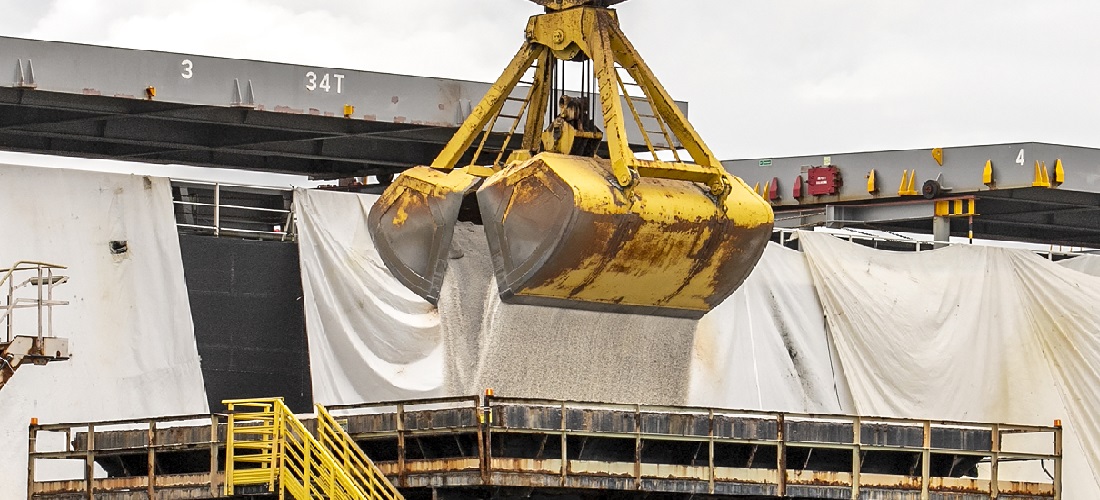
Brazil’s MOP stock could exceed historical average due to import pace
Aug, 31, 2023 Posted by Gabriel MalheirosWeek 202336
The disparity between the pace of potassium chloride (MOP) imports and domestic market sales could result in Brazil ending the year with a potash carryover stock exceeding 30% of the total, surpassing the historical average of 20-25%.
Potassium chloride (MOP) is the most consumed and imported fertilizer in Brazil. This nutrient is utilized across various crops, enhancing plant resistance to pests and tolerance to climate adversities such as droughts and frost.
In 2022, Brazil concluded the year with elevated carryover stocks of all fertilizers. Last year, the carryover stock of all nutrients totaled 8.4 million tons, compared to 7.3 million tons in 2021 and 6.2 million tons in 2020. MOP accounted for 2.1 million tons of the total stocks in the previous year, as opposed to 1.74 million tons in 2022 and 1.67 million tons in 2021.
While cumulative imports are below last year’s figures, they are outpacing domestic market demand, favoring an increase in MOP stocks. Additionally, there are indications that potassium chloride imports this year could surpass the total from 2022.
MOP imports in Brazil reached 7.1 million tons between January and July, a 15% decrease compared to the same period last year, according to customs data. The São Paulo Fertilizers and Agricultural Amendments Industry Union (Siacesp) anticipates MOP imports to reach 8.6 million tons between January and August, while domestic production is estimated at around 180,440 tons during the same period. Estimated MOP stocks in August hover around 4.5 million tons, based on an anticipated consumption of 6.5 million tons over the eight months. These estimated stocks for August are higher than the 3.8 million tons of MOP estimated in July.
Lineup data indicates that imports may reach 2.8 million tons between September and December, compared to 2.3 million tons in the same period last year. If these figures hold, MOP imports could reach 11.4 million tons in 2023, surpassing the 11.1 million tons of the previous year.
The chart below shows Brazil’s potassium chloride (hs 3104; 3105) imports by month from Jan 2019 and Jul 2023. The data is from DataLiner.
Potassium chloride imports | Jan 2019-Jul 2023 | WTMT
Source: DataLiner (click here to request a demo)
Should the estimated total fertilizer deliveries for the year reach 42.7 million tons, carryover stocks could approach 6.8 million tons. Consequently, the MOP stock could reach 1.7 million tons, assuming fertilizers account for 25% of the carryover stocks. However, MOP imports might remain elevated, potentially further increasing the national stock, as domestic market consumption lags behind the import market’s pace.
Total fertilizer deliveries to farmers reached 14.8 million tons from January to May, a 1.5% increase year-on-year, according to the National Association for Fertilizer Dissemination (Anda). Among the nutrients delivered to the market, potassium deliveries decreased by nearly 14%, while nitrogen (N) deliveries fell 7%. Phosphorus (P2O5) deliveries increased by 2% during the year.
Strong Prices Deter Farmers
Considering the planting calendar and import window, Brazilian farmers are expected to intensify purchases of MOP and nitrogen fertilizers for the 2023-24 corn crop. However, the exchange rate is discouraging rural producers from the market.
The corn exchange rate is around 75 sacks/ton in Sorriso, Mato Grosso, compared to 45 sacks/ton in January, the lowest level recorded this year. Each sack contains 60kg of corn. This means that farmers need the equivalent of 75 sacks of corn to buy 1 ton of a fertilizer basket, 30 sacks more than they needed at the beginning of the year.
Approximately 35% of the fertilizer needs for the 2023-24 winter corn crop have been purchased. Purchases in some regions are more advanced, mainly in northern Mato Grosso, in the BR-163 region, while only 10% of the needs have been secured in the southwestern region of Goiás.
The average price of MOP on a CFR basis in Brazil has risen by nearly $40/ton since the start of July due to reduced supply. The Vancouver port, a key export center for Canadian production, resumed operations after a strike disrupted flows for almost the entire month of July. The Canadian supply chain could take over a month to return to normal, which should support MOP prices in the Brazilian market. Around 70% of Canpotex’s production is exported through Vancouver, and Canada accounted for about 38% of Brazil’s imports, delivering 2.7 million tons out of the 7.1 million tons received between January and July.
Further delays in the delivery of Canadian MOP may occur, as prolonged drought in the Panama Canal is also affecting supply. Between 30 to 32 ships are expected to cross the canal daily in October, the start of the fiscal year. Normally, when the waterway operates at full capacity, 36 to 38 ships cross the canal daily.
Amid reduced availability of Canadian MOP, other sources are increasing supply to the Brazilian market. While the availability of products from Belarus has also been reduced, new offerings are expected to be available by the end of August for loading in October. Belarus has been in fierce competition, especially with Israel and Germany, to maintain its third-place position in the Brazilian market, accounting for 9% of deliveries from January to July. In the second half of 2022, the country was the fifth-largest supplier to the Brazilian market, accounting for 3% of the market, facing challenges in exporting MOP.
Source: Report by Flavia Bohone, Argus Brasil’s specialist in Agriculture and Fertilizers
To read the original news report, see: https://br.investing.com/analysis/descompasso-entre-importacao-e-demanda-domestica-afeta-estoque-de-fertilizante-200459317
-
Shipping
May, 15, 2023
0
Maersk completes divestment of Maersk Supply Service
-
Grains
Feb, 15, 2021
0
BA stock exchange maintains forecast for Argentina`s soybean and corn crop unchanged
-
Ports and Terminals
Mar, 22, 2023
0
Santos-Guaruja tunnel: new Sao Paulo gov’t wants work off the ground
-
Grains
May, 17, 2023
0
Argentina’s wheat crop to jump to 18mt in 2023/23, says grain exchange


